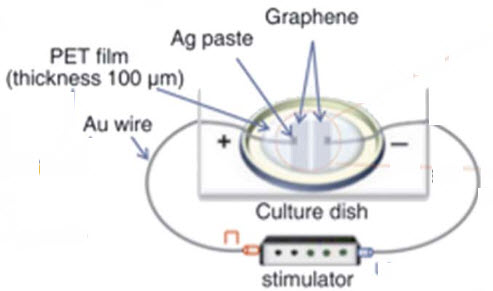Graphene’s potential to reshape neurosurgery
April 29, 2014

Schematic illustration of a recently developed graphene electric field stimulator (credit: Biomaterials)
Graphene may lead to exciting new applications in the diagnosis and treatment of neurological diseases, according to a report in the May issue of Neurosurgery, official journal of the Congress of Neurological Surgeons. The paper can also serve as a general introduction to the properties of graphene and its future uses.
Tobias A. Mattei, MD, of Invision Health/Brain & Spine Center, Buffalo, New York and Azeem A. Rehman, BS, of The University of Illinois College of Medicine at Peoria, suggest how graphene could contribute to future advances in several areas of neurosurgery, including:
- Cancer Treatment. Graphene nanoparticles may play a role in tumor-targeted imaging, as well as possible new therapeutic approaches involving photothermal or alternating electrical field stimulation therapies.
- Intensive Care Unit Monitoring. New electrochemical and optical biosensors may provide new approaches to neurologic monitoring in patients with stroke or traumatic brain injury.
- Neuroregeneration. Graphene materials may be used in new strategies to promote regeneration of nervous system tissues — for example, graphene-coated scaffolds to stimulate growth of injured peripheral nerves.
- Functional Neurosurgery. Improved electrophysiological monitoring systems may help in performing precisely targeted brain surgeries in patients with conditions such as epilepsy and movement disorders.
- Spinal Surgery. High-resistance graphene-based hardware may represent the next generation in instrumentation for spinal surgery.
However, much work remains before any of these advances become reality, the authors advise. While graphene has been shown to be biocompatible, more basic research is needed to examine the long-term biological effects of graphene implants and to answer other important clinical questions.
Abstract of Neurosurgery paper
Graphene, a monolayer atomic-scale honeycomb lattice of carbon atoms, has been considered the greatest revolution in metamaterials research in the past 5 years. Its developers were awarded the Nobel Prize in Physics in 2010, and massive funding has been directed to graphene-based experimental research in the last years. For instance, an international scientific collaboration has recently received a €1 billion grant from the European Flagship Initiative, the largest amount of financial resources ever granted for a single research project in the history of modern science. Because of graphene’s unique optical, thermal, mechanical, electronic, and quantum properties, the incorporation of graphene-based metamaterials to biomedical applications is expected to lead to major technological breakthroughs in the next few decades. Current frontline research in graphene technology includes the development of high-performance, lightweight, and malleable electronic devices, new optical modulators, ultracapacitors, molecular biodevices, organic photovoltaic cells, lithium-ion microbatteries, frequency multipliers, quantum dots, and integrated circuits, just to mention a few. With such advances, graphene technology is expected to significantly impact several areas of neurosurgery, including neuro-oncology, neurointensive care, neuroregeneration research, peripheral nerve surgery, functional neurosurgery, and spine surgery. In this topic review, the authors provide a basic introduction to the main electrophysical properties of graphene. Additionally, future perspectives of ongoing frontline investigations on this new metamaterial are discussed, with special emphasis on those research fields that are expected to most substantially impact experimental and clinical neurosurgery in the near future.